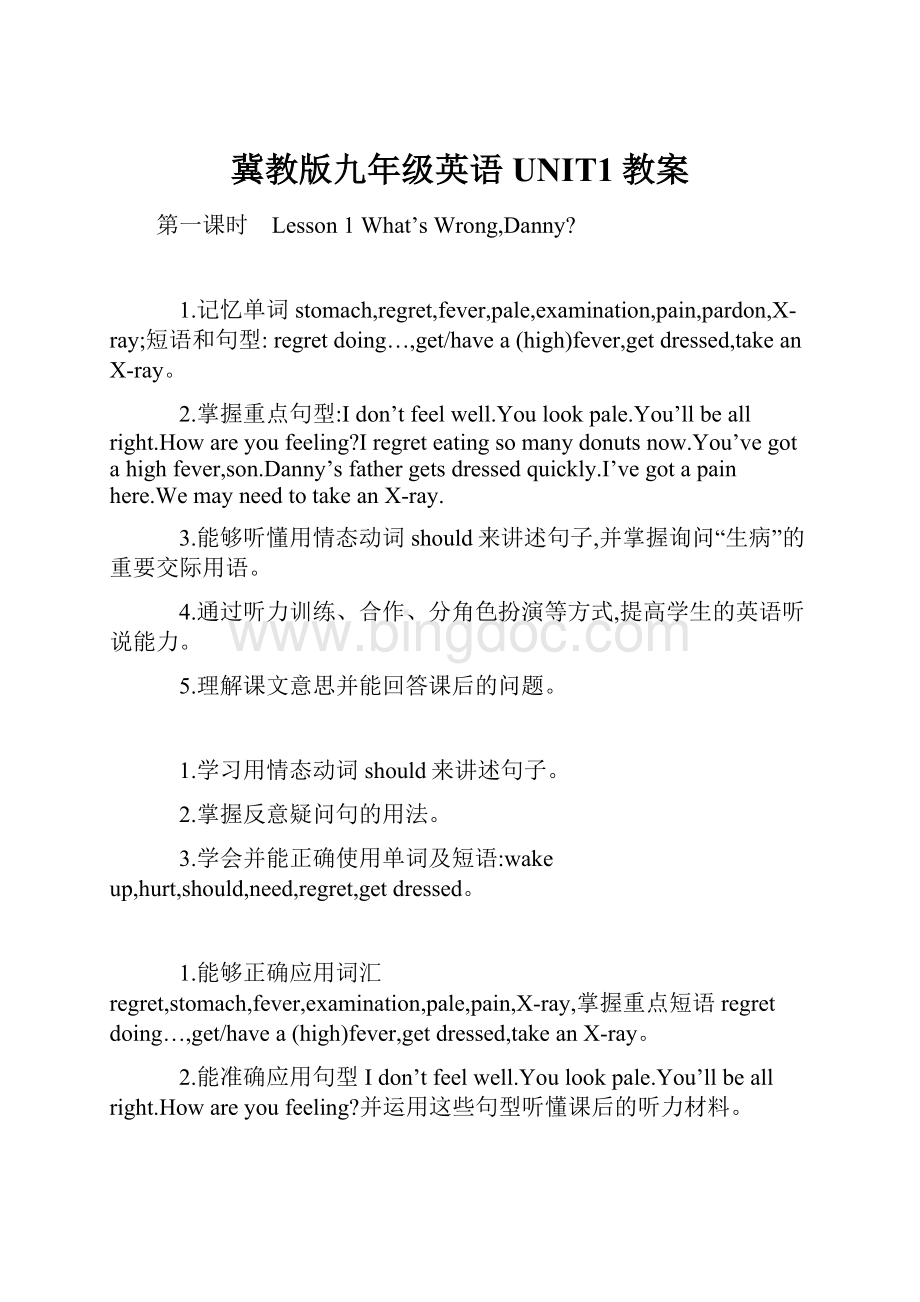冀教版九年级英语UNIT1教案.docx
《冀教版九年级英语UNIT1教案.docx》由会员分享,可在线阅读,更多相关《冀教版九年级英语UNIT1教案.docx(60页珍藏版)》请在冰点文库上搜索。

冀教版九年级英语UNIT1教案
第一课时 Lesson1What’sWrong,Danny?
1.记忆单词stomach,regret,fever,pale,examination,pain,pardon,X-ray;短语和句型:
regretdoing…,get/havea(high)fever,getdressed,takeanX-ray。
2.掌握重点句型:
Idon’tfeelwell.Youlookpale.You’llbeallright.Howareyoufeeling?
Iregreteatingsomanydonutsnow.You’vegotahighfever,son.Danny’sfathergetsdressedquickly.I’vegotapainhere.WemayneedtotakeanX-ray.
3.能够听懂用情态动词should来讲述句子,并掌握询问“生病”的重要交际用语。
4.通过听力训练、合作、分角色扮演等方式,提高学生的英语听说能力。
5.理解课文意思并能回答课后的问题。
1.学习用情态动词should来讲述句子。
2.掌握反意疑问句的用法。
3.学会并能正确使用单词及短语:
wakeup,hurt,should,need,regret,getdressed。
1.能够正确应用词汇regret,stomach,fever,examination,pale,pain,X-ray,掌握重点短语regretdoing…,get/havea(high)fever,getdressed,takeanX-ray。
2.能准确应用句型Idon’tfeelwell.Youlookpale.You’llbeallright.Howareyoufeeling?
并运用这些句型听懂课后的听力材料。
StepⅠ.Leadin
Leadingin【情景1】
T:
Hello,boysandgirls.Nowyouaretheninthgraders.CongratulationstoyouandIwillbewithyoutoachieveagreatsuccessthisyear!
ThisweekwewilllearnUnit1StayHealthy.Stayinghealthyisnotonlyaboutourphysicalbodies,it’salsoimportanttoexerciseourbrainsbyhavinghobbiesandgoodhabits.Todaywe’lllearnLesson1What’sWrong,Danny?
ShowtheThinkAboutItquestionsatthetopofLesson1onPPTandhelpthestudentstalkaboutthem.
T:
Whenyoudon’tfeelwell,whatdoyouusuallydo?
S1:
Istayinbedandhavearest.
S2:
Idrinksomehotteawithhoneyorsugar.
S3:
Itakesomemedicine.
S4:
Iusuallytellmyparentsandaskthemtotakemetothehospital.
…
T:
Whenyoudon’tfeelwell,it’snicetohavesomeonewhocantakecareofyou.MyhusbandtakescareofmewhenI’msick.Butifyougetreallysick,yourfamilymemberscan’thelpyou.Whenyougetreallysick,youshouldgotothehospitalandseeadoctor.Whatdoesthedoctordo?
Ss:
Thedoctorchecksyou,andthengivesyoumedicinetomakeyoufeelbetter.
T:
That’sright.Whatistheworstillnessyou’veeverhad?
S1:
TheworstillnessI’veeverhadwasthechickenpox.IwasveryweakandIhadaveryhighfever.MyskinwasitchyandIalwaysfelttired.
T:
Isee.Didyougotothedoctor?
Howdidthedoctorhelpyou?
S1:
Thedoctorcheckedmyfeverandgavemeabloodtest.Andthenhegavemesomemedicine.Ithelpedmegetbetter.
T:
That’sgood.Whataboutyou?
S2:
Pneumonia.
T:
Howdidyourecoverfromyourillness?
S2:
Istayedinhospitalforseveraldays.Thankstothedoctorsandnurses,Isoonrecoveredfrommyillness.
T:
That’sgood.Canyouguesswhathappensinthislesson?
S3:
Dannydoesn’tfeelwellsohisparentstakehimtothedoctor.
T:
Ithinkyou’reright.Let’sreadandfindout.
[设计意图] 教师通过设计几个学生感兴趣的问题导入新课,从而调动了学生们的学习积极性,参与课堂教学活动的热情。
Leadingin【情景2】
1.T:
Hello,boysandgirls.Nowyouaretheninthgraders.CongratulationstoyouandIwillbewithyoutoachieveagreatsuccessthisyear!
Weallhaveexperiencesaboutbeingsick.Ifyouaresick,whatdoyouusuallydo?
S1:
Istayinbed.
S2:
Idrinkhottea.
S3:
Igotothehospital.
…
2.GetthestudentstolookatthepictureonPPT.
Showstudentsthefollowingpicture.
Dividestudentsintosmallgroups(4~6studentsagroup).AskthesegroupstodiscussthefollowingquestionsonPPT.
•Canyouguesswhatishappening?
•Whatcanthedoctorbesaying?
•Whatcanthepatientbesaying?
•Ifyoudon’tfeelwell,whatshouldyoudo?
•Whatistheworstillnessyouhaveeverhad?
Suggestedanswers:
•Agirlisill.Thedoctorislookingoverthepatient.
•Thedoctormaybesaying:
What’swrongwithyou?
Haveyoutakenyourtemperaturetoday?
Doyouhaveafever?
Didyouhaveanythingtoeat?
Whatdidyoueat?
Don’tworry.There’snothingserious.
•Thepatientmaybesaying:
Mystomachhurts.
Ican’tsleepwellallnight.
Ihavetakenmytemperatureandthetemperatureis…
Yes,Iatetendonutsfordessert.
Idon’twanttoeatanything.
•IfIdon’tfeelwell,myfatherwilltakemetoseeadoctor.
•Theanswerisvarious.
[设计意图] 通过PPT课件和图片提示,努力创造更加真实的语言交际情景,让学生围绕本单元的中心话题“看病”进行学习和知识积累,学习运用目标语言知识。
StepⅡ.Presentation
Readthetextandfindoutsomekeyphrasesandsentences.
Keyphrases:
•wakeup
•situp
•allright
•getdressed
•haveafever
Keysentences:
•Idon’tfeelwell.
•Iregreteatingsomanydonutsnow.
•Mystomachhasneverhurtthismuchbefore.
•Youaresick,aren’tyou?
•Danny’sfathergetsdressedquickly.
•Hepointstotherightsideofhisstomach.
☆教材解读☆
1.It’s3:
00a.m.Dannywakesuphisparents.
wakeup醒来,把某人吵醒,叫醒,是由“动词+副词”构成的动副短语。
当其宾语是名词时,名词既可以放在wake与up中间,也可以放在wakeup的后面;但当宾语是代词时,代词只能放在wakeup中间。
Pleasewakeherup!
请把她叫醒!
Wakeupyoursister.
=Wakeyoursisterup.叫醒你妹妹。
2.What’swrong,Danny?
What’swrong?
意为“怎么了?
”,常用来询问别人发生了什么事情。
【拓展】
(1)表示“……怎么了/出什么事了?
”还可用:
What’sthematter/trouble(with…)?
或What’s…trouble?
(2)Somethingiswrongwith…相当于Thereissomethingwrongwith…,表示“……出了毛病”。
3.Idon’tfeelwell.
◆本句表示“我感觉不舒服”,常用一般现在时和现在进行时两种时态。
◆feel在本句中为系动词,意为“感觉”,其后通常跟形容词作表语。
4.Iregreteatingsomanydonutsnow.
regret既可作动词,也可作名词,意为“遗憾,后悔,懊悔,惋惜”。
regretdoingsth.表示“后悔做了某事”,指对做过的事情感到遗憾、后悔。
regrettodosth.表示“对要做某事表示遗憾”。
Iregrettedtotellhimthathehadbeendismissed.Tomysurprise,hesaidtome,“Ihavenoregrets.Ionlyregrethavingtakenthewrongjob.”我遗憾地告诉他他被解雇了。
使我惊奇的是,他对我说:
“我没有任何遗憾。
我唯一后悔的是选错了工作。
”
5.Mystomachhasneverhurtthismuchbefore.
◆本句中的this为副词,经常用于口语中,意为“到此程度,如此”。
此处可用so来代替this。
◆表达身体疼痛或不舒服,可以用下面的结构:
(1)某人+have/has+病症。
(2)某人+have/has+a/an+headache/toothache/stomachache/backache等。
(3)某人+have/has+a+sore+发病部位。
(4)某人+hurt(s)+身体部位或反身代词。
(5)某部位+hurt(s)。
(6)某人+have/has+a+pain+inone’s+身体部位。
(7)Thereissomethingwrongwithone’s+身体部位。
6.Youaresick,aren’tyou?
本句是一个反意疑问句。
反意疑问句通常由一个陈述句和一个简短的疑问句组成。
当陈述句为肯定句时,疑问句为否定;当陈述句为否定句时,疑问句为肯定。
7.Danny’sfathergetsdressedquickly.
getdressed穿衣服,指给自己穿衣服,getundressed脱下衣服。
8.Hepointstotherightsideofhisstomach.
pointto为固定短语,意为“指向,指着”,to是介词,着重于指的方向。
【拓展】
(1)pointat指着,at是介词,着重于指的对象。
(2)pointout指出,out是副词,指给某人指出方向、要点、错误等。
[设计意图] 教师引导学生找出本课的重点短语和句型,进行讲解,扫清了学生理解文章的障碍。
StepⅢ.Reading
1.Readthetext.Askonestudentatatimetoreadapartofthedialogue.Monitorthestudents’pronunciationandcomprehension.
2.ShowLet’sDoIt!
No.1thefourquestionsonPPT.
Askstudentstoreadthetextagainandanswerthequestions.
(1)WhydoesDannywakeuphisparentsearlyinthemorning?
(2)WhatdoesDannyregretdoing?
(3)Howdotheygettothehospital?
(4)WhatdoesDr.LingaskDannytodo?
【Keys】
(1)Becausehedoesn’tfeelwell.Hisstomachhurts.
(2)Heregretseatingsomanydonuts. (3)Theydrivetothehospital. (4)Dr.LingasksDannytostayinthehospital.
[设计意图] 通过学生们反复朗读课文,加强学生们的记忆,同时也锻炼学生们的口语表达能力。
StepⅣ.Listening
1.ShowLet’sDoIt!
No.2onPPT.
Listentothedialogueandtickthecorrectanswers.
(1)What’swrongwiththewoman?
Shehasahighfever.
Shehasacold.
(2)Didthemedicinehelphergetwell?
Yes,itdid.
No,itdidn’t.
(3)Whatadvicedidthemangivetothewoman?
Sheshouldgotoseethedoctor.
Sheshouldtryothermedicine.
【Keys】
(1)Shehasacold.
(2)No,itdidn’t.(3)Sheshouldgotoseethedoctor.
2.PlaytheaudiotapeforLesson1.Playitonceandaskthestudentsjusttolisten.
3.Playtheaudiotapeasecondtimeandaskthestudentstoanswerthequestions.
4.Checktheanswers.
[设计意图] 学生反复听磁带并跟读。
第一次听,要求大概理解对话的意思。
第二次听,改为一句一句听,仔细听出每句的内容,并完成问题,通过反复听磁带并跟读培养学生们的听说能力。
StepⅤ.PairWork:
Let’sDoIt!
No.4
1.Dividestudentsintosmallgroups(4~6studentsagroup).Askthemtomakeupsomedialoguesoftheirown.Thedialoguemustbeaboutthestoriesinthehospital.Thisisagoodtimeforstudentstousetheirimagination.
Theteachercanhelpstudentspreparesomethingthatisusefulintheaction.Givethemsomeusefulsentences:
Doctor:
Whatiswrongwithyou?
/Whatisthematter?
Howareyoufeelingnow?
Haveyoutakenyourtemperature?
Didyoueatanythingthismorning?
Don’tworry.Thereisnothingserious.Youwillbeallrightsoon.
Takethismedicinethreetimesaday.
Drinkmorewaterandyouhadbetterstayinbed.
Eatmorefruitandvegetables.
Don’teattoomuchmeat.
Patient:
Ihavegotaheadache/toothache/stomachache/cold/feverandsoon.
Ican’tsleepwellthesedays.
Idon’twanttoeatanything.
2.Askeachpairtopresenttheirdialoguesinfrontoftheclass.
[设计意图] 教师创设情景让学生们做对话,能够吸引学生的学习兴趣,调动学生的学习积极性,并且在对话中巩固了本课所学的一些词组和词的用法。
StepⅥ.Practice
Ⅰ.CompleteLet’sDoIt!
No.3.
Studentsdotheexerciseindependently,andthenchecktheanswersingroups.
Ⅱ.根据句意及首字母提示补全单词
1.Ifyoueatsomebadfood,yours willhurt.
2.Dannyhasacoldtoday.Hehasahighf .
3.Thedoctortookmetoane room.
4.Thereisnocolourintheboy’sfaceandhelooksp .
5.You’dbettertakeanX sothedoctorcanseeyourproblemwiththeclearpicture.
Ⅲ.根据汉语意思完成句子
1.我妈妈每天早晨叫醒我,我感到很幸福。
Mymother everymorningandI veryhappy.
2.我的胃以前从没这样疼过。
Mystomach never .
3.我感冒得很严重。
I a .
4.他生病一周了。
He foraweek.
5.丹尼,你怎么了?
,Danny?
【Keys】 Ⅰ.1.colour 2.clear 3.stupid 4.couldn’t
Ⅱ.1.stomach 2.fever 3.examination 4.pale 5.X-ray
Ⅲ.1.wakesmeup,feel 2.has,hurtsomuchbefore3.havegot,badcold 4.hasbeenill/sick 5.What’swrong
[设计意图] 锻炼学生的思考能力,同时培养学生的情感。
StepⅦ.Summary
Inthisclass,we’velearntsomethingaboutseeingadoctor.Also,wehavelearntsomekeyexpressionsandsentences.
[设计意图] 给学生以总结,让学生明确这节课的学习内容。
StepⅧ.Homework
1.Finishofftheremainingexercisesintheactivitybook.
2.Previewthenextlessoninthestudent’sbook.
[设计意图] 让学生通过习题巩固本节课内容,并提前做好预习。
Lesson1:
What’sWrong,Danny?
Mainphrases:
Mainsentences:
wakeup Idon’tfeelwell.